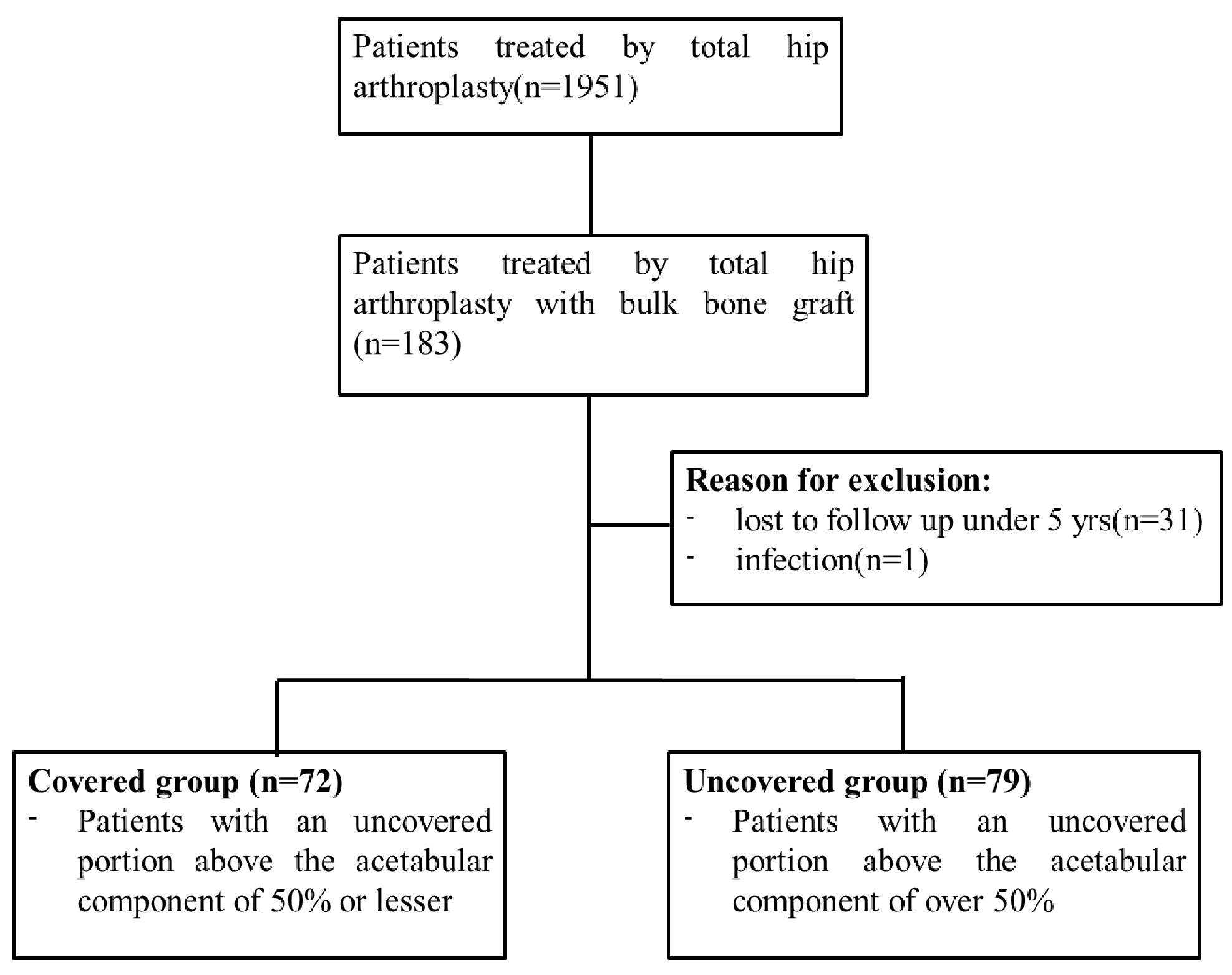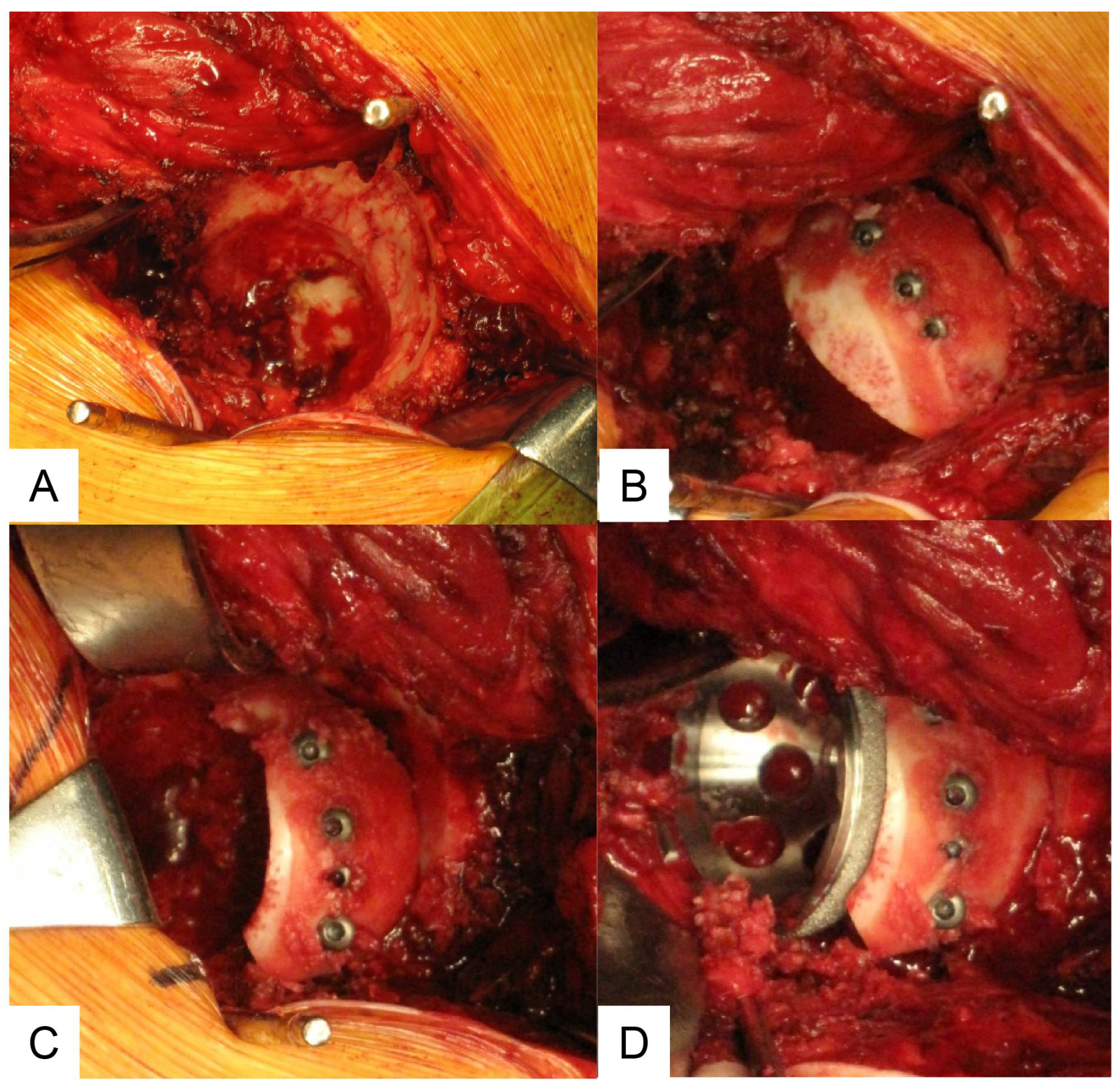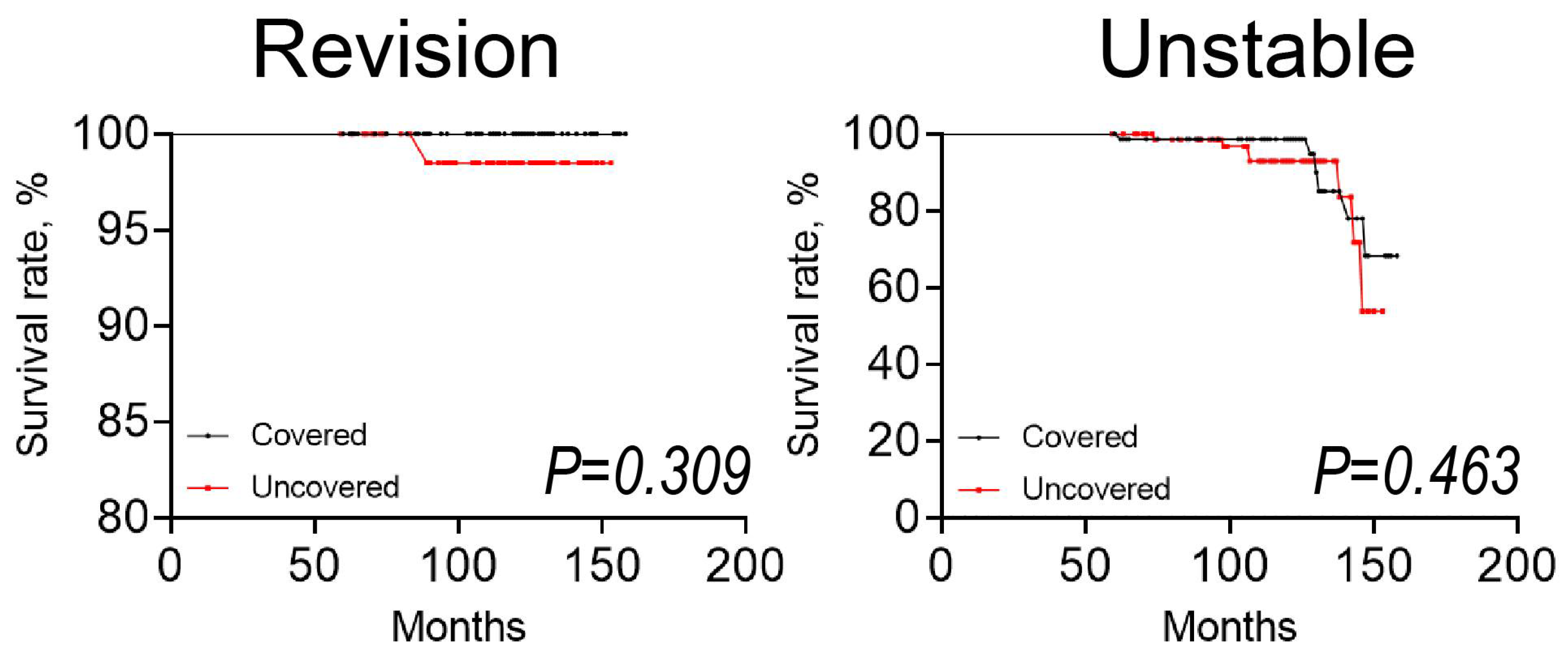Midterm Results of Severe Hip Dysplasia after Using a Cementless Acetabular Component with Bulk Bone Graft in Total Hip Arthroplasty: A Minimum Five-Year Follow-Up Study
Abstract
1. Introduction
2. Materials and Methods
3. Results
4. Discussion
5. Conclusions
Author Contributions
Funding
Institutional Review Board Statement
Informed Consent Statement
Data Availability Statement
Acknowledgments
Conflicts of Interest
References
- Holzapfel, B.M.; Greimel, F.; Prodinger, P.M.; Pilge, H.; Noth, U.; Gollwitzer, H.; Rudert, M. Total hip replacement in developmental dysplasia using an oval-shaped cementless press-fit cup. Int. Orthop. 2012, 36, 1355–1361. [Google Scholar] [CrossRef]
- Kaneuji, A.; Sugimori, T.; Ichiseki, T.; Yamada, K.; Fukui, K.; Matsumoto, T. Minimum ten-year results of a porous acetabular component for Crowe I to III hip dysplasia using an elevated hip center. J. Arthroplast. 2009, 24, 187–194. [Google Scholar] [CrossRef] [PubMed]
- Rogers, B.A.; Garbedian, S.; Kuchinad, R.A.; Backstein, D.; Safir, O.; Gross, A.E. Total hip arthroplasty for adult hip dysplasia. J. Bone Jt. Surg. 2012, 94, 1809–1821. [Google Scholar] [CrossRef] [PubMed]
- Pitto, R.P.; Schikora, N. Acetabular reconstruction in developmental hip dysplasia using reinforcement ring with a hook. Int. Orthop. 2004, 28, 202–205. [Google Scholar] [CrossRef] [PubMed][Green Version]
- Pagnano, W.; Hanssen, A.D.; Lewallen, D.G.; Shaughnessy, W.J. The effect of superior placement of the acetabular component on the rate of loosening after total hip arthroplasty. J. Bone Jt. Surg. 1996, 78, 1004–1014. [Google Scholar] [CrossRef]
- Russotti, G.M.; Harris, W.H. Proximal placement of the acetabular component in total hip arthroplasty. A long-term follow-up study. J. Bone Jt. Surg. 1991, 73, 587–592. [Google Scholar] [CrossRef]
- Dorr, L.D.; Tawakkol, S.; Moorthy, M.; Long, W.; Wan, Z. Medial protrusio technique for placement of a porous-coated, hemispherical acetabular component without cement in a total hip arthroplasty in patients who have acetabular dysplasia. J. Bone Jt. Surg. 1999, 81, 83–92. [Google Scholar] [CrossRef] [PubMed]
- Hartofilakidis, G.; Stamos, K.; Karachalios, T.; Ioannidis, T.T.; Zacharakis, N. Congenital hip disease in adults. Classification of acetabular deficiencies and operative treatment with acetabuloplasty combined with total hip arthroplasty. J. Bone Jt. Surg. 1996, 78, 683–692. [Google Scholar] [CrossRef]
- Barrack, R.L.; Newland, C.C. Uncemented total hip arthroplasty with superior acetabular deficiency. Femoral head autograft technique and early clinical results. J. Arthroplast. 1990, 5, 159–167. [Google Scholar] [CrossRef]
- Alp, N.B.; Akdağ, G.; Erdoğan, F. Long-term results of total hip arthroplasty in developmental dysplasia of hip patients. Jt. Dis. Relat. Surg. 2020, 31, 298–305. [Google Scholar] [CrossRef]
- Rodriguez, J.A.; Huk, O.L.; Pellicci, P.M.; Wilson, P.D., Jr. Autogenous bone grafts from the femoral head for the treatment of acetabular deficiency in primary total hip arthroplasty with cement. Long-term results. J. Bone Jt. Surg. 1995, 77, 1227–1233. [Google Scholar] [CrossRef] [PubMed]
- Shinar, A.A.; Harris, W.H. Bulk structural autogenous grafts and allografts for reconstruction of the acetabulum in total hip arthroplasty. Sixteen-year-average follow-up. J. Bone Jt. Surg. 1997, 79, 159–168. [Google Scholar] [CrossRef] [PubMed]
- Abdel, M.P.; Stryker, L.S.; Trousdale, R.T.; Berry, D.J.; Cabanela, M.E. Uncemented acetabular components with femoral head autograft for acetabular reconstruction in developmental dysplasia of the hip: A concise follow-up report at a mean of twenty years. J. Bone Jt. Surg. 2014, 96, 1878–1882. [Google Scholar] [CrossRef] [PubMed]
- Ozden, V.E.; Dikmen, G.; Beksac, B.; Tozun, I.R. Long-term retrospective study on the placement of the cementless acetabular cup and clinical outcomes in patients undergoing femoral head autografting for hip dysplasia and total hip arthroplasty. J. Orthop. Sci. 2018, 23, 525–531. [Google Scholar] [CrossRef]
- Shimamura, M.; Katayama, N.; Ohura, H. Mean 14-year Outcomes of Hybrid Total Hip Arthroplasty Using Bulk Femoral Head Autografts for Acetabular Reconstruction. J. Arthroplast. 2023, 38, 2667–2672. [Google Scholar] [CrossRef]
- Suzuki, M.; Masuda, T.; Kanno, T.; Inoue, M.; Abe, S.; Yamamoto, T. Minimum 10-Year Survivorship of Uncemented Acetabular Reconstruction with Bulk Femoral Head Autografting in Crowe Type IV Developmental Hip Dysplasia. J. Arthroplast. 2024; in press. [Google Scholar] [CrossRef]
- Kim, M.; Kadowaki, T. High long-term survival of bulk femoral head autograft for acetabular reconstruction in cementless THA for developmental hip dysplasia. Clin. Orthop. Relat. Res. 2010, 468, 1611–1620. [Google Scholar] [CrossRef]
- Morsi, E.; Garbuz, D.; Gross, A.E. Total hip arthroplasty with shelf grafts using uncemented cups. A long-term follow-up study. J. Arthroplast. 1996, 11, 81–85. [Google Scholar] [CrossRef]
- Spangehl, M.J.; Berry, D.J.; Trousdale, R.T.; Cabanela, M.E. Uncemented acetabular components with bulk femoral head autograft for acetabular reconstruction in developmental dysplasia of the hip: Results at five to twelve years. J. Bone Jt. Surg. 2001, 83, 1484–1489. [Google Scholar] [CrossRef]
- Zhang, L.; Alkentar, R.; Manó, S.; Szabó, J.; Mankovits, T.; Csernátony, Z. Biomechanical Comparison of the Roof Step Cut Technique with the Bulk Bone Graft Technique During Total Hip Arthroplasty for Hip Dysplasia: A Finite Element Analysis. Acta Chir. Orthop. Traumatol. Cech. 2023, 90, 301–313. [Google Scholar] [CrossRef]
- Gross, A.E.; Allan, D.G.; Catre, M.; Garbuz, D.S.; Stockley, I. Bone grafts in hip replacement surgery. The pelvic side. Orthop. Clin. N. Am. 1993, 24, 679–695. [Google Scholar] [CrossRef]
- Jasty, M.; Anderson, M.J.; Harris, W.H. Total hip replacement for developmental dysplasia of the hip. Clin. Orthop. Relat. Res. 1995, 311, 40–45. [Google Scholar]
- Kim, Y.H.; Kim, J.S. Total hip arthroplasty in adult patients who had developmental dysplasia of the hip. J. Arthroplast. 2005, 20, 1029–1036. [Google Scholar] [CrossRef] [PubMed]
- Shetty, A.A.; Sharma, P.; Singh, S.; Tindall, A.; Kumar, S.V.; Rand, C. Bulk femoral-head autografting in uncemented total hip arthroplasty for acetabular dysplasia: Results at 8 to 11 years follow-up. J. Arthroplast. 2004, 19, 706–713. [Google Scholar] [CrossRef]
- Sugano, N.; Nishii, T.; Nakata, K.; Masuhara, K.; Takaoka, K. Polyethylene sockets and alumina ceramic heads in cemented total hip arthroplasty. A ten-year study. J. Bone Jt. Surg. 1995, 77, 548–556. [Google Scholar] [CrossRef]
- DeLee, J.G.; Charnley, J. Radiological demarcation of cemented sockets in total hip replacement. Clin. Orthop. Relat. Res. 1976, 121, 20–32. [Google Scholar] [CrossRef]
- Tompkins, G.S.; Jacobs, J.J.; Kull, L.R.; Rosenberg, A.G.; Galante, J.O. Primary total hip arthroplasty with a porous-coated acetabular component. Seven-to-ten-year results. J. Bone Jt. Surg. 1997, 79, 169–176. [Google Scholar] [CrossRef] [PubMed]
- Gerber, S.D.; Harris, W.H. Femoral head autografting to augment acetabular deficiency in patients requiring total hip replacement. A minimum five-year and an average seven-year follow-up study. J. Bone Jt. Surg. 1986, 68, 1241–1248. [Google Scholar] [CrossRef]
- Mulroy, R.D., Jr.; Harris, W.H. Failure of acetabular autogenous grafts in total hip arthroplasty. Increasing incidence: A follow-up note. J. Bone Jt. Surg. 1990, 72, 1536–1540. [Google Scholar] [CrossRef]
- Li, H.; Mao, Y.; Oni, J.K.; Dai, K.; Zhu, Z. Total hip replacement for developmental dysplasia of the hip with more than 30% lateral uncoverage of uncemented acetabular components. Bone Jt. J. 2013, 95-B, 1178–1183. [Google Scholar] [CrossRef]
- Hooten, J.P., Jr.; Engh, C.A.; Heekin, R.D.; Vinh, T.N. Structural bulk allografts in acetabular reconstruction. Analysis of two grafts retrieved at post-mortem. J. Bone Jt. Surg. 1996, 78, 270–275. [Google Scholar] [CrossRef]





| Covered | Uncovered | p-Value | |
|---|---|---|---|
| Number | 72 | 79 | |
| Age, years | 56 (8.0) | 58 (8.8) | 0.118 |
| BMI, kg/m2 | 22.4 (3.0) | 24.3 (3.7) | <0.001 |
| Sex, n (%) | 0.024 | ||
| male | 4 (5.6) | 14 (17.7) | |
| female | 68 (94.4) | 65 (82.3) | |
| Crowe type, n (%) | <0.001 | ||
| I | 10 (13.9) | 16 (20.3) | |
| II | 15 (20.9) | 33 (41.7) | |
| III | 24 (33.3) | 16 (20.3) | |
| IV | 23 (31.9) | 14 (17.7) |
| Covered | Uncovered | p-Value | |
|---|---|---|---|
| Median cup diameter, mm | 47.7 | 49.7 | <0.001 |
| (3.2; 40 to 56) | (2.9; 42 to 58) | ||
| Cup inclination, degrees | 42.3 | 40.0 | 0.062 |
| (8.2; 24 to 63) | (7.2; 24 to 68) | ||
| Hip center, mm | |||
| Vertical | 22.7 | 22.3 | 0.678 |
| (6.2; 9 to 44) | (5.7; 8 to 21) | ||
| Horizontal | 31.4 | 32.5 | 0.445 |
| (5.1; 17 to 41) | (4.0; 23 to 57) |
| Covered | Uncovered | p-Value | |
|---|---|---|---|
| Graft coverage | |||
| Horizontal coverage, % | 39.4 | 57.9 | <0.001 |
| (10, 6.8 to 49.9) | (5.5; 50 to 72) | ||
| Center edge angle, degree | |||
| CE I | −0.3 | −14.2 | <0.001 |
| (9.8; −19.8 to 28.8) | (8.5; −35.8 to 0.6) | ||
| CE II | 50.7 | 46.9 | 0.018 |
| (9.4; 34.4 to 74.8) | (9.7; 19.6 to 74.8) | ||
| CE III | 49.5 | 45.6 | 0.019 |
| (10.0; 31.0 to 81.1) | (8.8; 30.8 to 71.6) |
| Covered | Uncovered | p-Value | |
|---|---|---|---|
| Findings of bone graft (radiolucent), n (%) | 0.058 | ||
| residual bone graft shadow | 7 (9.7) | 15 (19.0) | |
| partial sclerosis | 10 (13.9) | 18 (22.8) | |
| complete incorporation | 55 (76.4) | 46 (58.2) | |
| Cup fixation, n (%) | 0.774 | ||
| stable | 56 (77.8) | 64 (81.0) | |
| radioluscent line (<2 mm) | 10 (13.9) | 8 (10.1) | |
| unstable | 6 (8.3) | 7 (8.9) |
Disclaimer/Publisher’s Note: The statements, opinions and data contained in all publications are solely those of the individual author(s) and contributor(s) and not of MDPI and/or the editor(s). MDPI and/or the editor(s) disclaim responsibility for any injury to people or property resulting from any ideas, methods, instructions or products referred to in the content. |
© 2024 by the authors. Licensee MDPI, Basel, Switzerland. This article is an open access article distributed under the terms and conditions of the Creative Commons Attribution (CC BY) license (https://creativecommons.org/licenses/by/4.0/).
Share and Cite
Konno, T.; Shimizu, T.; Inoue, M.; Masuda, T.; Terkawi, M.A.; Iwasaki, N.; Takahashi, D. Midterm Results of Severe Hip Dysplasia after Using a Cementless Acetabular Component with Bulk Bone Graft in Total Hip Arthroplasty: A Minimum Five-Year Follow-Up Study. Bioengineering 2024, 11, 841. https://doi.org/10.3390/bioengineering11080841
Konno T, Shimizu T, Inoue M, Masuda T, Terkawi MA, Iwasaki N, Takahashi D. Midterm Results of Severe Hip Dysplasia after Using a Cementless Acetabular Component with Bulk Bone Graft in Total Hip Arthroplasty: A Minimum Five-Year Follow-Up Study. Bioengineering. 2024; 11(8):841. https://doi.org/10.3390/bioengineering11080841
Chicago/Turabian StyleKonno, Takuya, Tomohiro Shimizu, Masahiro Inoue, Takeshi Masuda, Mohamad Alaa Terkawi, Norimasa Iwasaki, and Daisuke Takahashi. 2024. "Midterm Results of Severe Hip Dysplasia after Using a Cementless Acetabular Component with Bulk Bone Graft in Total Hip Arthroplasty: A Minimum Five-Year Follow-Up Study" Bioengineering 11, no. 8: 841. https://doi.org/10.3390/bioengineering11080841
APA StyleKonno, T., Shimizu, T., Inoue, M., Masuda, T., Terkawi, M. A., Iwasaki, N., & Takahashi, D. (2024). Midterm Results of Severe Hip Dysplasia after Using a Cementless Acetabular Component with Bulk Bone Graft in Total Hip Arthroplasty: A Minimum Five-Year Follow-Up Study. Bioengineering, 11(8), 841. https://doi.org/10.3390/bioengineering11080841






